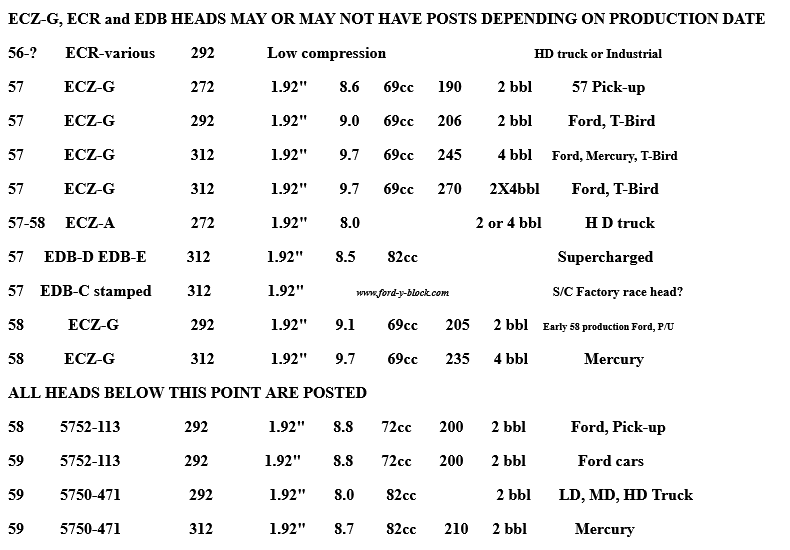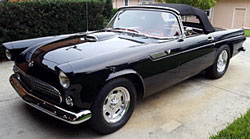|
Author
|
Message
|
|
ac289ace
|
|
|
Group: Forum Members
Last Active: 4 Years Ago
Posts: 34,
Visits: 371
|
Ted, Thank you very much for the running the numbers with what I had provided. It seems to point towards there not being a major problem with the configuration, but I realize its an estimate based on murky input from me.
The machine shop is starting the teardown so I should know fairly quickly if there are any major issues, and also have some actual info on chamber volume and cam configuration.
|
|
|
|
|
Lord Gaga
|
|
|
Group: Forum Members
Last Active: Last Year
Posts: 464,
Visits: 183.3K
|
"I’m the type who would make a plaster mold of the piston top and cc the head myself because I have the tools."
Use paraffin wax instead. Bring the piston near the top of bore, level, pour melted wax in and let cool. Push wax mold out with piston and cc it. Works great. Get wax in canning supply section.
"FREE SAMPLE"
|
|
|
|
|
ac289ace
|
|
|
Group: Forum Members
Last Active: 4 Years Ago
Posts: 34,
Visits: 371
|
I've been on the road and not posting, but I am home now and thought I would provide an update. The machine went through the block and there are many issues with it so we will be boring .060" over and going completely through it. I plan to use my 312 crank in the 292 block and we will be getting new pistons so I do not need to worry about the pop up pistons and how they might affect the CR. I want to do a mild performance build so will probably go with stock pistons and a mild cam.
Is there a good off the shelf cam that might provide some mild performance benefits?
|
|
|
|
|
KULTULZ
|
|
|
Group: Forum Members
Last Active: Last Week
Posts: 1.8K,
Visits: 306.3K
|
Just a note - ECZ-G CYL HEADS were also used into 1958 production (Date Codes Are Needed To Confirm). The 1.64 rocker arms were last used in 1957 production. 1958 went back to 1.43 and the 1958/59 SEVEN DIGIT CHARACTER PN SYSTEM shows on the rockers as CASTING ID. The 1.64 ratio rocker arms were later replaced with the 1.43 ratio rocker arm for service replacement.  SOURCE - http://www.ford-y-block.com/cylinderheadchart.htm
____________________________
|
|
|
|
|
PF Arcand
|
|
|
Group: Forum Members
Last Active: Last Year
Posts: 3.3K,
Visits: 238.8K
|
About a Cam? link from this site to John Mummert's site. ( www.ford-y-block.com.) He lists several Cams with specs.. Also various parts, kits & up grade pieces etc..
Paul
|
|
|
|
|
Ted
|
|
|
Group: Administrators
Last Active: Last Week
Posts: 7.5K,
Visits: 205.8K
|
ac289ace (7/22/2021)
I want to do a mild performance build so will probably go with stock pistons and a mild cam.
Is there a good off the shelf cam that might provide some mild performance benefits?The Isky E4 is a proven upgrade over the factory 1957 camshaft without being overly rowdy. Just enough rumble to let you know you have a ‘better’ camshaft but not a heavy loper.
  Lorena, Texas (South of Waco) Lorena, Texas (South of Waco)
|
|
|
|
|
YBLOCKMERC
|
|
|
Group: Forum Members
Last Active: 7 Months Ago
Posts: 194,
Visits: 20.6K
|
I'm going to give a largely seat of the pants description of what I did and how it works with a 292 +.40 and unposted G heads with 1.54 rockers. I wanted a cam to approximate the specs from the '57 245 hp, 4V factory item. I'm not sure the piston configuration, it was part of a Mummert rebuild kit with hypereutectic pistons. My build was done in 2004, but not actually run til 2012. My goal was to replicate the performance of a '57 4V Y-block. The engine propels a '54 Merc convertible with a C-4 automatic and stock '54 rear end. Bottom line is I couldn't be happier with this engine. It sounds great with dual 30" glasspacks, especially on acceleration. It cruises effortlessly at all speeds and will push you back in the seat nicely when you're looking for a little speed satisfaction....freeway on ramps are a blast. It gets 13 - 15 mpg and runs on 87 octane without any pinging. All in all I got exactly what I was looking for and I definitely brag about it at car shows. Good luck with your choices. P.S. - Lower compression is your friend for a street engine, somewhere under 9.0 I would guess. It lets you run regular gas and still provides enjoyable performance.
Marc
|
|
|
|
|
one piece at a time
|
|
|
Group: Forum Members
Last Active: 6 Months Ago
Posts: 50,
Visits: 21.9K
|
Something to consider my experience anyway. “ Off the shelf “ cam e4 comes with a close lobe separation which produces a lower vacuum. If running power assist brakes may cause issues. It did for me anyway. I had to can my booster and go to hydro boost . Several hundred dollars more. My new build will be getting an E4 but with a custom order wider separation. You should also take into consideration what transmission and converter if it’s an automatic your running .
Duane
|
|
|
|
|
PF Arcand
|
|
|
Group: Forum Members
Last Active: Last Year
Posts: 3.3K,
Visits: 238.8K
|
Duane's point about the E-4 lobe seperation is well taken.. I believe that point has come up before... As to references to the 1957 Cam.. Oregon Cams in Vancouver Washington (across the river from the Oregon border) has copies of it available, taken off an unused original.. I don't recall the price but it wasn't unreasonable.
Paul
|
|
|
|
|
Florida_Phil
|
|
|
Group: Forum Members
Last Active: 2 Years Ago
Posts: 1.2K,
Visits: 285.6K
|
Here is some personal feedback you may find useful. My TBird engine is a .060 over 292 with G heads, flat top pistons, 57 intake, Holley 465 carb and 57 ignition. Except for the 312 crank, it's very similar to the engine you are working on. I have run both the E4 Isky cam 301444 cam (duration 260) and the 301333 cam (duration 270) in my street Y-Blocks. I have a 301333 cam in my car now. Both cams are good street cams. The 301333 is significantly more radical at idle. My car has a manual transmission and it idles at 800 rpm. The E4 rumbles like a healthy engine. The 301333 pops through the exhaust pipes with a definite lope. Both cams will operate at low RPM without bucking or hesitation. My 301333 cam pulls about 14 pounds of vacumn at idle. Mid range torque is excellent. Friends that have ridden with me say they are surprised that a Y-Block runs that well. I never rev my engine over 5,500 rpm, so I can't comment on high rpm performance. If you like a quieter milder mannered car, I would choose the E4. If you like a touch of race car attitude, you may like the 301333 better. Keep in mind that my car is a light TBird with a manual transmission and a lower rear gear ratio.

|
|
|
|